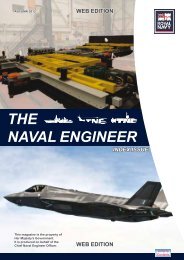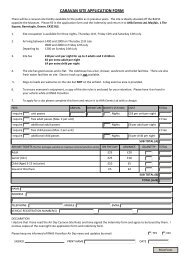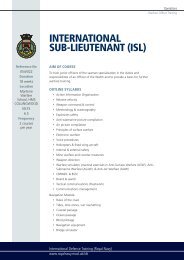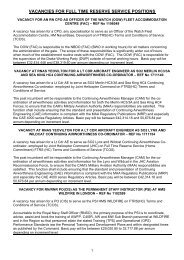THE NAVAL ENGINEER
THE NAVAL ENGINEER
THE NAVAL ENGINEER
You also want an ePaper? Increase the reach of your titles
YUMPU automatically turns print PDFs into web optimized ePapers that Google loves.
11<br />
processes can be summarised as<br />
follows [34]:<br />
3 O 2<br />
+ e – → 2 O 3<br />
+ e – (7)<br />
NO + O 3<br />
→ NO 2<br />
+ O 2<br />
(8)<br />
HC + O 3<br />
→ OHC + O 2<br />
(9)<br />
NOx + OHC + catalyst →<br />
N 2<br />
+ H 2<br />
O + CO 2<br />
+ catalyst<br />
(10)<br />
Complex reactions of OHCs with<br />
exhaust gases also result in the<br />
formation of N 2<br />
O and NH 3<br />
. N 2<br />
O is<br />
a greenhouse gas with a 100-year<br />
global warming potential 298 times<br />
greater than CO 2<br />
. [46] NH 3<br />
is a<br />
human irritant and is dangerous to<br />
the environment [47].<br />
An alternative approach is to use<br />
a two-stage HC-SCR and NH 3<br />
-<br />
SCR. The first stage is optimised<br />
to produce NH 3<br />
, which is then<br />
used with a conventional platinum<br />
catalyst (as used with urea-SCR)<br />
to further reduce NO x<br />
[48]. This has<br />
achieved promising results using<br />
an exhaust stream NO:NO 2<br />
ratio of<br />
1:1; because real diesel exhaust<br />
streams contain much more NO,<br />
it is likely that an NTP device<br />
would be needed upstream of the<br />
two-stage catalyst to achieve a<br />
satisfactory system performance.<br />
Additional fuel consumption<br />
here is less predictable than the<br />
reductant consumption of urea-<br />
SCR systems. To avoid a reduction<br />
in the ship’s range, the additional<br />
fuel requirement could be between<br />
half (hypothesised potential) and<br />
twice (for a current test system) the<br />
urea tank volume for a urea-SCR<br />
system.<br />
Where an external fuel reformer<br />
or NTP device is used the system<br />
(excluding reductant) will have a<br />
greater volume than urea-SCR.<br />
Volumetric gas flow to catalyst<br />
volume ratios of between 1.8 and<br />
8.3 s-1 for 182 to 200 ppm NO x<br />
feeds have been quoted, the high<br />
end of which is similar to urea-SCR<br />
[34] [48]. These fuel reformers<br />
operate with diesel fuel at between<br />
140°C and 160°C and at these<br />
temperatures the fuel vapour will<br />
ignite readily [34], posing significant<br />
safety challenges for RN ships.<br />
Noble metal catalysts are not<br />
required so the catalyst matrix in<br />
the exhaust stream is likely to be<br />
less expensive than with urea-<br />
SCR [34]. Where NTP is not used,<br />
higher temperatures of 375°C to<br />
425°C are required for adequate<br />
conversion rates [48]. In this case,<br />
it may be necessary to heat the<br />
exhaust gases to facilitate efficient<br />
operation. This will system increase<br />
size, power consumption and IR<br />
signature when the system is in<br />
use.<br />
Practical marine HC-SCR<br />
systems are at an early stage<br />
of development and constitute<br />
a high level of technical risk.<br />
The moderate system size and<br />
complexity is likely to result in a<br />
moderate acquisition cost and<br />
the low to moderate reductant<br />
(diesel) consumption penalty and<br />
possible requirement for catalyst<br />
replacements will lead to moderate<br />
operational costs.<br />
Dissolution in a Liquid Medium<br />
(Figure 6)<br />
Scrubbers are a common method of<br />
removing SO x<br />
from diesel exhausts.<br />
These work by dissolving sulphur<br />
oxides in seawater [10]. NO has<br />
a low solubility in seawater so<br />
this approach is largely ineffective<br />
at reducing NO x<br />
concentrations.<br />
However, NO 2<br />
readily hydrolyses in<br />
water to give nitrous<br />
and nitric acids [44]:<br />
2 NO 2<br />
+ H 2<br />
O →<br />
HNO 2<br />
+ HNO 3<br />
(11)<br />
By first converting<br />
NO to NO 2<br />
, NO x<br />
can<br />
be removed from the<br />
exhaust stream. The<br />
conversion is most<br />
effectively conducted<br />
using NTP and this<br />
overall process is<br />
termed ‘Wet NTP’ [11].<br />
The process of<br />
NO 2<br />
hydrolysis<br />
is accelerated by<br />
the presence of a<br />
base such as NH 3<br />
or sodium sulphite<br />
in solution, which<br />
prevents saturation<br />
Seawater in<br />
Discharge<br />
overboard or<br />
treatment and<br />
recirculation<br />
Diesel Engine<br />
of the removal liquid by nitrate<br />
(NO 3–<br />
) and nitrite (NO 2–<br />
) ions [44].<br />
This requires a significant volume<br />
of base to be carried on board.<br />
Much of the recent research has<br />
focussed on the use of these,<br />
especially where a combined NTP<br />
and dissolution device is used [38]<br />
[39] [44].<br />
For ships it is more practical to<br />
avoid acid saturation of the removal<br />
liquid by increasing the volume<br />
flow rate of sea water. This method<br />
has been shown to be effective:<br />
Ecospec [28] market a scrubber<br />
that removes around 66% of NO x<br />
whilst Balon and Clark [49] project<br />
that 90% NO x<br />
removal is feasible<br />
by scaling up their system. Both of<br />
these used a two-stage oxidation<br />
and dissolution process.<br />
These scrubber systems also<br />
remove SO x<br />
, PM, HCs and some<br />
CO 2<br />
from the exhaust. All of these<br />
processes result in significant<br />
acidification of the operating<br />
liquid, and pumping this directly<br />
overboard poses significant local<br />
marine pollution and global ocean<br />
acidification problems. Storing the<br />
liquid on board is impractical for a<br />
densely packed warship and the<br />
usual approach is to neutralise it<br />
with an alkaline injector or dilute it<br />
with additional seawater until it is<br />
has a pH greater than 6.5 [15].<br />
Strainer<br />
Filtration<br />
plant<br />
Scrubbing<br />
tower<br />
Strainer<br />
Contaminants to<br />
sludge tank<br />
Oxidation<br />
catalyst or NTP<br />
device<br />
20:1 1:20<br />
Exhaust<br />
Seawater<br />
sprays<br />
Exhaust gas NO:NO 2<br />
Ratio<br />
Figure 6: Dissolution in a Liquid Medium<br />
Jump to<br />
Contents

















